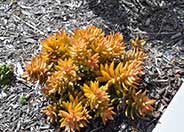
Common name:Kleinia
Botanical name:Senecio mandraliscae
This succulent perennial will grow to about 1.5' tall and 2' wide. It has curved, blue/gray leaves that are about 3.5" long and very slender.

Common name:Kangeroo Paws Big Red
Botanical name:Anigozanthos 'Big Red'
Anigozanthos flavidus 'Tall Red' is a perennial with dark green, smooth, swordlike evergreen leaves. It produces spikes of striking, fuzzy, tubular flowers in yellow-green, tinged with red that are curved at the tips. The flowers attract hummingbirds. Flowers bloom from late spring to fall if spent flowering spikes are cut to the ground. It makes for a good cut flower.

Common name:Yellow Bush Spurge
Botanical name:Euphorbia characias wulfenii
Broad clusters of lime green flowers appear in winter and spring. These flowers create dense, round cylindrical masses! This evergreen perennial has upright stems forming a 4' tall dome-shaped bush. Crowded all along the stems are narrow, blue-green leaves. Once it's established, it is drought tolerant. Until the seeds ripen, the flower color holds with only slight fading. At that point, the stalks should be cut out at the base. Use gloves as sap is poisonous.

Common name:Red New Zealand Flax
Botanical name:Phormium tenax 'Rubrum'
New Zealand Flax is an excellent accent plant for the garden. Evergreen leaves are long, narrow, and grow upright. Clusters of flowers grow on spikes above the foliage in late spring and summer. 'Rubrum' is a large, bold plant with stiff, vertical, strap-like leaves that arise from its base and are dark purplish-red in color. It should be grown in full sun.

Common name:Orange Sedum
Botanical name:Sedum nussbaumeranian
This succulent perennial will grow best in a wall pot or hanging basket due to its long stems. It has light, gray green leaves that grow over one another to give off a "braided" look. The flowers are pink to deep red and bloom in spring and summer.
Designer:
Photographer: Vicki Anderson
Incorporate compost 6" into your soil to retain water, reduce compaction, feed earthworms, and provide valuable nutrients to your plants.
Develop healthy soil for plants that are vigorous and naturally pest-resistant.